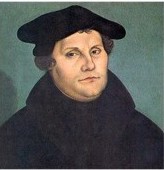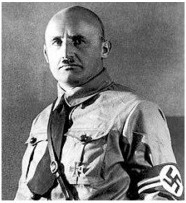1517 Luther publishes his 95 Theses - and formulates a creed whereby humans are considered to be deeply corrupt, powerless to save themselves, and justified only through god's grace. The individual relates directly to god (without the intercession of a Church); that church is a place for sermons, not sacraments; and that only the Bible has authority (not the writings of Church Fathers). Protestant reformers Martin Luther and John Calvin agree with the post-Pelagian Augustine that Original Sin completely destroys liberty (total depravity), thereby presuming a lack of free will.
 Luther was, unfortunately, also a vicious anti-Semite. In On the Jews and their Lies he asks:
"What shall we Christians do with this rejected and condemned people, the Jews":
"First, to set fire to their synagogues or schools … so that God might see that we are Christians …
Second, I advise that their houses also be razed.
Third, I advise that all their prayer books and Talmudic writings …be taken from them.
Fourth, I advise that their rabbis be forbidden to teach henceforth on pain of loss of life and limb …
Fifth, I advise that safe-conduct on the highways be abolished completely for the Jews…
Sixth, I advise that … all cash and treasure of silver and gold be taken from them …
Seventh, I recommend putting a flail, an ax, a hoe, a spade, a distaff, or a spindle into the hands of young, strong Jews and Jewesses and letting them earn their bread in the sweat of their brow … But if we are afraid that they might harm us, … then let us eject them forever from the country …"
A little further on, he writes "we are at fault in not slaying them."
Luther was, unfortunately, also a vicious anti-Semite. In On the Jews and their Lies he asks:
"What shall we Christians do with this rejected and condemned people, the Jews":
"First, to set fire to their synagogues or schools … so that God might see that we are Christians …
Second, I advise that their houses also be razed.
Third, I advise that all their prayer books and Talmudic writings …be taken from them.
Fourth, I advise that their rabbis be forbidden to teach henceforth on pain of loss of life and limb …
Fifth, I advise that safe-conduct on the highways be abolished completely for the Jews…
Sixth, I advise that … all cash and treasure of silver and gold be taken from them …
Seventh, I recommend putting a flail, an ax, a hoe, a spade, a distaff, or a spindle into the hands of young, strong Jews and Jewesses and letting them earn their bread in the sweat of their brow … But if we are afraid that they might harm us, … then let us eject them forever from the country …"
A little further on, he writes "we are at fault in not slaying them."

Julius Streicher
As a result of Luther’s influence, his Prince, John Frederick I, Elector of Saxony, in 1543 revoked concessions granted to his Jewish community; John of Brandenburg-Küstrin repealed the safe conduct of Jews in his territories; Luther's followers sacked the synagogue of Berlin in 1572 and in the following years the Jews were driven out of Brandenburg and several other German Lutheran states.
Shortly after the Kristallnacht, Martin Sasse, Bishop of the Evangelical Lutheran Church in Thuringia, published a compendium of Luther’s writings; Sasse: "On November 10, 1938, on Luther's birthday, the synagogues are burning in Germany."
The city of Nuremberg presented a first edition of On the Jews and their Lies to Julius Streicher, editor of the Nazi newspaper Der Stürmer, on his birthday in 1937. It was publicly exhibited in a glass case at the Nuremberg rallies. On December 17, 1941, seven Lutheran regional church confederations issued a statement agreeing with the policy of forcing Jews to wear the yellow badge, "since after his bitter experience, Luther had strongly suggested preventive measures against the Jews and their expulsion from German territory."
~~~~~~~~
 Luther was, unfortunately, also a vicious anti-Semite. In On the Jews and their Lies he asks:
"What shall we Christians do with this rejected and condemned people, the Jews":
"First, to set fire to their synagogues or schools … so that God might see that we are Christians …
Second, I advise that their houses also be razed.
Third, I advise that all their prayer books and Talmudic writings …be taken from them.
Fourth, I advise that their rabbis be forbidden to teach henceforth on pain of loss of life and limb …
Fifth, I advise that safe-conduct on the highways be abolished completely for the Jews…
Sixth, I advise that … all cash and treasure of silver and gold be taken from them …
Seventh, I recommend putting a flail, an ax, a hoe, a spade, a distaff, or a spindle into the hands of young, strong Jews and Jewesses and letting them earn their bread in the sweat of their brow … But if we are afraid that they might harm us, … then let us eject them forever from the country …"
A little further on, he writes "we are at fault in not slaying them."
Luther was, unfortunately, also a vicious anti-Semite. In On the Jews and their Lies he asks:
"What shall we Christians do with this rejected and condemned people, the Jews":
"First, to set fire to their synagogues or schools … so that God might see that we are Christians …
Second, I advise that their houses also be razed.
Third, I advise that all their prayer books and Talmudic writings …be taken from them.
Fourth, I advise that their rabbis be forbidden to teach henceforth on pain of loss of life and limb …
Fifth, I advise that safe-conduct on the highways be abolished completely for the Jews…
Sixth, I advise that … all cash and treasure of silver and gold be taken from them …
Seventh, I recommend putting a flail, an ax, a hoe, a spade, a distaff, or a spindle into the hands of young, strong Jews and Jewesses and letting them earn their bread in the sweat of their brow … But if we are afraid that they might harm us, … then let us eject them forever from the country …"
A little further on, he writes "we are at fault in not slaying them."
